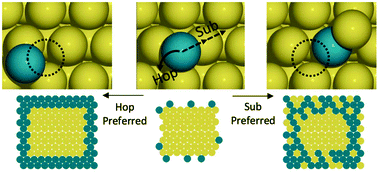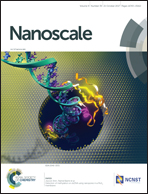Toward rational nanoparticle synthesis: predicting surface intermixing in bimetallic alloy nanocatalysts†
Abstract
We present a database of first-principles calculated activation energy barriers for two competitive processes involving bimetallic adatom-surface permutations of ten transition metals: (i) adatom “hopping” diffusion and (ii) adatom substitution into the surface. We consider the surface structure sensitivity of these events as well as coverage effects. We find that surface hopping mechanisms are facile and always preferred to substitution events on close-packed fcc(111) and hcp(0001) surfaces. However, surface atom substitution is more facile on the more open fcc(100) surfaces and is competitive with adatom surface hopping, which is more difficult than on the close-packed surfaces. By comparing the absolute and relative magnitudes of the energetics of hopping and substitution, our calculations can offer qualitative predictions of intermixing and other phenomena relevant to nanocrystal growth, such as the tendency to form intermixed alloys or core–shell structures during layer-by-layer nanoparticle synthesis involving a given bimetallic pair, and thereby inform the rational design and synthesis of novel bimetallic nanomaterials.



 Please wait while we load your content...
Please wait while we load your content...